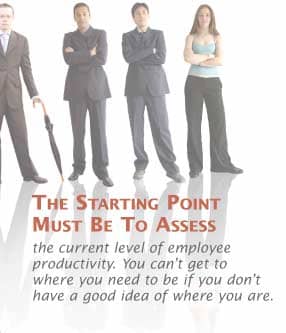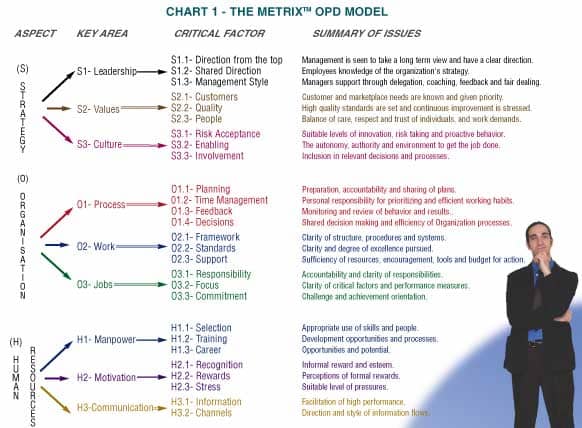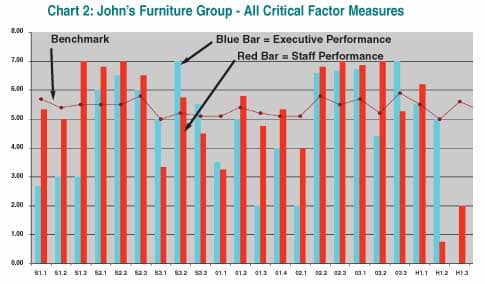Part 2: Once employee productivity has been measured, you are ready to take the six important steps to ensure continuous improvement.
Step One Assess the organization
The senior management of any retail furniture organization has an obligation to its employees, shareholders and customers to provide the best possible leadership and direction. A key step in providing this direction is to continuously assess organizational productivity and identify company strengths and weaknesses.
The starting point for a furniture storeowner or manager must be, therefore, to assess the current level of employee productivity. You can’t get to where you need to be if you don’t have a good idea of where you are.
The ability of senior managers to identify the areas that really need improvement is a critical action step. In the August/September issue of FURNITURE WORLD, the first installment in this series, (posted to the operations management article index on www.furninfo.com) introduced the Metrix™ OPD Model that can help managers to:
- Identify the appropriate factors which enable them to manage more effectively in real time.
- Have a set of standards that will tell them how well they are doing today.
- Determine the action or actions that need to be taken in a particular situation.

Identification must become an ongoing process if the organization wants to continually improve the productivity of its people. In order to create an ongoing process, key areas should be identified and measurements taken.
There are many ways that companies have traditionally measured the factors that are critical to increasing productivity. For the purposes of this article we will use the term “Critical Success Factors” to describe ways of helping people at all levels to determine the key areas of responsibility in their jobs.
Once these Critical Success Factors have been identified, appropriate standards or measurements can be assigned to them to help gauge productivity gains. Critical Success Factors can be assigned to every organizational area in your store. Some examples of organizational areas and the associated Critical Success Factors commonly used to measure productivity are:
Sales: Revenue generated vs. planned.
Services: Percentage of first time fixes or call-backs. For example, a call center might use the following performance metrix:
- Calls answered within 4 rings = 100%.
- Calls fulfilled at 1st pass = 98%.
- Calls escalated to stage 2 = 5%.
Support: Number of customer complaints, that might be measured based on:
- The number of deliveries per week = 100%
of planned work.
- Refunds due to complaints accepted = zero.
Clerical: Number of invoices processed per day.
Finance: Turnaround time of credit checks
In addition, to day-to-day performance standards, many businesses use more strategic standards, which relate to the bottom line
In the Retail sector, organizations often create ratios that compare assets and/or liabilities to evaluate employee performance. Some examples of this type of ratio are:
- Revenues to total number of employees.
- Expenses to total number of employees.
- Average profit per employee.
Clearly home furnishings retailers need management tools to help senior management identify all the Critical Success Factors that limited resources might be applied to, so that employee productivity can be increased.
Without a coordinated assessment of the organization that helps to pinpoint the exact cause of a performance problem, in times when there is a need for increased productivity, most organizations will simply encourage their people to work harder and longer.
The fact is that often, other specific factors are acting as a drag on productivity, and these have little to do with working harder and longer. Furthermore, they cannot easily be determined by the traditional measures mentioned earlier. It is, therefore, useful to take a step back and identify the specific factors that can be targeted to most efficiently achieve desired performance improvements (See Chart 1).

Once senior management of an organization has this information, the task of setting appropriate goals for increasing the productivity of its people will become clearer and easier.
Step Two Create & Communicate The Vision
Without vision, no company can reach its full potential. That’s because an organization’s support systems such as Human Resource Management, IT or Customer Relationship Management and the performance of its employees are tied together by a corporate vision.
Support Systems will be discussed more fully in the December/January 2006 issue of FURNITURE WORLD. For now it is sufficient to acknowledge that Support Systems form the basis by which an organization creates and distributes its non-human resources. This area addresses marketing, accounting systems, policies and procedures, and business tools such as computers.
A powerful vision that is understood at all levels of an organization is a factor that serves as the first bridge allowing support systems to affect performance. It allows senior managers to provide focus and direction for organizational efficiency
To take this second step, the entire senior management team needs to be brought together. The president or Chief Executive Officer should be prepared to articulate his/her vision of how the organization will look in three to five years. The senior management team can then begin the process of identifying the long-term direction, focus, strategies and structural changes that might be needed to achieve this vision.
This process, undertaken by senior management, is accomplished by first identifying the current culture and values of the organization (see the Part 1 in the August/September issue of FURNITURE WORLD, also posted to the operations management article index on furninfo.com). Then the team can agree to the specific areas that are in need of change in order to support the desired organizational vision. Once these changes are identified, the team can create and agree to organizational and functional missions as well as work objectives.
Finally, these missions and objectives must be shared throughout all levels of the organization.
The process of communicating this vision and encouraging feedback from all organizational levels is a key element. It is also the prerequisite for building the second bridge: Commitment.
Step Three Build A Base Of Commitment
Commitment is not something that an organization can demand; it must be earned. One of the ways that an organization earns commitment is to insure that there are opportunities and vehicles for all levels of employees to participate in two-way communication.
One of these vehicles is the sharing of information between the management team and its employees, providing feedback through a mature communication approach and/or suggestion scheme in the senior management process. Another highly effective way to foster commitment is proper delegation, that enables staff to be properly tasked to achieve positive results for the organization and also for the individual’s self-esteem. Delegation is comprised of three aspects, all of which tie into the commitment factor.
First, the organization must assist employees in defining their jobs, their responsibilities and the standards they must live up to. The interdependencies needed to achieve desired results should also be made explicit. An example of such an interdependency would operate in a Sales Associates group where a performance bonus is effected by the successful merchandising of products.
Second, a process needs to be created for reviewing results based on corporate expectations, and an agreement must be reached formalizing the relative accountabilities of all parties involved.
Third, there must be an understanding by all levels involved in a task or project regarding the relative authority of each employee. This should describe which decisions employees can make without “checking back” and which ones will need formal approval from a superior. This information should be clearly written and accessible in each employee’s Job Description and reviewed annually. This will also provide the basis for an employee appraisal system, a process essential to effective organization performance management.
Lack of planning and agreement on definitions of jobs, expectations and authority often causes conflicts and fosters low levels of commitment between the employee and the organization creating a lack of empowerment and lower job satisfaction levels. The process of delegation can be greatly enhanced by a written plan that is developed and agreed upon by all parties involved.
The final aspect of commitment that needs to be addressed is the organization’s attitude regarding risk taking. Risk taking must be encouraged and supported if employees are to take initiatives to exceed their job responsibilities. Simply having a policy in place isn’t sufficient. An effective review system must be established to maintain the movement in risk taking driven by market needs. Managers and employees at all levels must clearly recognize expectations for risk taking within their organization.
Consider for example, a buyer at an overseas furniture show confronted with a situation where an immediate decision must be made to capture good prices. This employee and the organization will be well served by a system that describes his or her freedom to take this risk as well as a review process by which future risk taking actions might be guided.
An organization can measure its risk taking systems by examining the way in which expectations are created. It should also support the behaviors that encourage more risk taking through one-on-one meetings, training and good mentoring. A careful analysis of the formal/ informal reward and support systems regarding risk taking is very important with regular reviews of the target set and clear Key Performance indicators shown to avoid ambiguity. Finally, an assessment of the way resources are used and distributed is key to helping people take more appropriate and better risks.
It is important to note that each of the “Dimensions” of Individual Performance and Support Systems can develop independently of each other within an organization. Once the two Bridging Factors of Vision and Commitment are solidly in place they can begin acting as conduits to bring these broader dimensions together.
Critical Factors At John’s Furniture Group
We revisit our ongoing case study at John’s Furniture Group (see August/September 2005 FURNITURE WORLD Magazine) .

The chart (below) shows the staff’s perceptions of the organization measured across all the company’s “Factors” (see chart 1). The black line represents a benchmark against which internal results can be measured. Survey results are shown for the two key levels of employees, namely, Staff and Executives. The benchmark can be internally generated from previous survey(s), from an external source or possibly from a benchmark recognized as being “excellent”.
Let’s look at one factor, Culture, the key factors associated with S3 (see chart 1).
Culture is comprised of the following sub factors:
- Risk Acceptance (S3.1.) - Suitable levels of innovation, risk taking and proactive behavior.
- Enabling (S3.2.) - The autonomy, authority and environment to get the job done.
- Involvement (S3.3.) - Inclusion in relevant decisions and processes.
Focusing on the sub-factor Risk Acceptance (S3.1.), our survey shows that the staff group feels that barriers/ constraints exist on risk taking, innovation and ability to respond to change. Allowing risk taking in a controlled way has major advantages for this organization. A review of responsibilities to ensure that each job is appropriately balanced with others is, therefore, undertaken at John’s Furniture Group.
Let’s look at the survey results for Enabling (sub-factor S3.2). This measures the autonomy, authority and cultural environment available to get the job done. We see that staff and executives are at levels above the benchmark. This factor measures the extent to which people have been given the autonomy and authority to do their jobs, and also to resolve issues. There appears to be a culture of democracy at John’s. The effect is seen in positive levels of delegation, employee involvement and ownership, plus excellent levels of employee motivation.
The Involvement factor (S3.3) measures the extent to which people feel the organization encourages their involvement in decisions. This degree of involvement affects their work performance and also the degree to which they feel committed to the organization. There appears to be a feeling among staff members that the organization doesn’t encourage participation in decision making. As a result, managers at John’s furniture group will need to develop a plan to drive improvement in this area.
Next Issue
In the December/January issue of FURNITURE WORLD, this series will continue with the next three action steps that retail managers can take to achieve real and continuous gains in employee productivity.
Philip Pugh, an experienced consultant and Business Manager specializing in Process and Organizational improvement and is the Operations Director for Tribune US, Inc (TUS) a consulting company based in Washington DC. Tribune US, Inc. TUS is a subsidiary of Tribune Business Systems Ltd., a London based company. TUS offers a range of products and services to customers in the Retail, Financial Services, Insurance and Manufacturing sectors. Tribune US, Inc is a recognized specialist in the field of Process Management and Process efficiency with applications to assist in continuous improvement. If you have questions about this article or would like to try a 30-day trial using Process Expert Professional - a recognized approach, contact Mr. Pugh at pugh@furninfo.com.